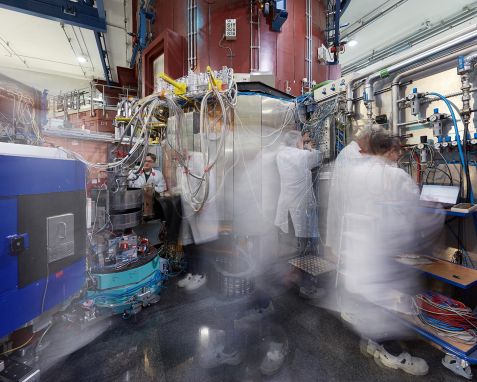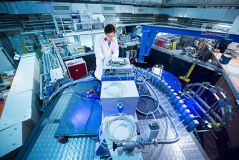MLZ is a cooperation between:
 > Technische Universität München
> Technische Universität München > Helmholtz-Zentrum Hereon
> Helmholtz-Zentrum Hereon
 > Forschungszentrum Jülich
> Forschungszentrum Jülich
MLZ is a member of:
 > LENS
> LENS > ERF-AISBL
> ERF-AISBL
MLZ on social media:

MLZ (eng)
Lichtenbergstr.1
85748 Garching
21.11.2017
Twisted magnetic fluctuations in superconductors

Scientist and technician at the three axes spectrometer PUMA - as seen with the artists' eye. © Bernhard Ludewig
A Chinese research group led by Prof. Jun Zhao at Fudan University found the twisted magnetic excitations in the new Fe-based superconductor Li0.8Fe0.2ODFeSe from a neutron scattering experiment on PUMA, MLZ and Oak Ridge National Laboratory in the United State. This finding provides one step further in understanding of the mechanism in high temperature superconductivity.
Li0.8Fe0.2OHFeSe is a new type of iron-selenide superconductor where the FeSe layers are separated by (Li0.8Fe0.2)OH blocking layers. Due to intercalated hydrogen atoms, it was not feasible to conduct an inelastic neutron scattering experiment in the beginning, but the research group at Fudan University successfully grew the phase-pure single crystal and fully deuterated their single-crystalline sample by a hydrothermal ion exchange method.
From the inelastic neutron scattering measurement on PUMA, first of all, it is found that the magnetic resonant mode is located at the weird wave vector which connects two electron Fermi pockets, indicating that the Copper pairing symmetry still remains as sign-reversed type as other iron-based superconductors. More surprise comes from the high energy regime: the spin excitation slowly disperses outward in the low-energy region, and above 60 meV the dispersion suddenly turns into an inward shape, forming the twisted dispersion. Such behavior was not seen in any other Fe-based superconductors by far. Instead, it rather resembles to the well-known “hour-glass” dispersion in copper-oxide based high Tc superconductors, in which the highest superconducting transition temperature was recorded among unconventional superconductors. This experimental observation implies that the higher superconducting transition temperature may favor not only the sign-changing pairing channels, but also the twisted spin excitations.
Original publication:
Structure of spin excitations in heavily electron-doped Li0.8Fe0.2ODFeSe superconductors
B. Pan, Y. Shen, D. Hu, Y. Feng, J.T. Park, A.D. Christianson, Q. Wang, Y. Hao, H. Wo, Z. Yin, T.A. Maier and J. Zhao
Nature Communications 8 (1), 123 (2017)
Related News
-
18.05.2016
Reversed symmetry
MLZ is a cooperation between:
 > Technische Universität München
> Technische Universität München > Helmholtz-Zentrum Hereon
> Helmholtz-Zentrum Hereon
 > Forschungszentrum Jülich
> Forschungszentrum Jülich
MLZ is a member of:
 > LENS
> LENS > ERF-AISBL
> ERF-AISBL
MLZ on social media:




